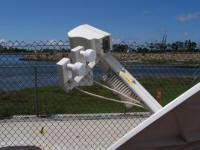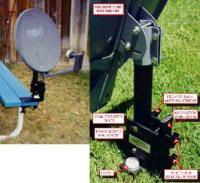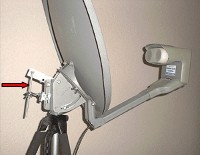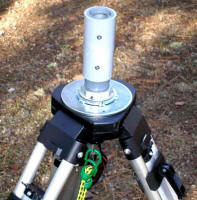
Please wait, I'm coming over...

Last Changed 6/14/2010 |
||
|
There is an array of ways to mount a satellite dish when on the
road. There are those available for purchase and an array of home
built versions. This is a sampling of the available mounts. Our main criteria for evaluating tripods was; can the mounting mast be leveled on unlevel ground. That criteria made H&G tripods our choice. |
||
Bird-On-a-Wire (BOW) |
||
 |
You will sometimes see an older DirecWay satellite Internet dish that is also receiving satellite TV signals. This extra hardware is
referred to as Bird-On-a-Wire (BOW). This hardware is not in production anymore but can sometimes be found for sale. The BOW
hardware only worked with the older DirecWay dishes, the fiberglass ones or the DataStorm automatic roof units. BOW does not always work. It depends on your TV service, DishTV (satellites 110, 119, 129) or DirecTV (satellites 99, 101, 103, 110, 119), and which HughesNet (nee DirecWay) satellite (83, 87, 91, 95, 99, 117, 127) you are assigned to. There is a limit on how far off the TV satellites can be from the HughesNet satellite. BOW does not receive the new DirecTV satellites for HDTV. If you can live with HDTV limitation, and are on a useable HughesNet satellite, the BOW has the advantage of a single tripod solution. |
|
Winegard TR-2000 Tripod |
||
 |
The Winegard TR-2000 is a small simple tripod. A plastic body receives the three legs and the shaft for the dish. We have not used this tripod but the fixed length legs indicate that this tripod would only be good on level ground. | |
Winegard TR-3500 Tripod |
||
 |
The Winegard
TR-3500 is a simple tripod. A metal body has the three legs and
the shaft for the dish attached. The TR-3500 comes with a carrying
bag. We had this tripod. We found the fixed length legs made it near impossible to level this tripod on unlevel ground |
|
Bullseye Mount |
||
 |
The Bullseye mount is
an interesting setup. It is based upon an adjustable clamp that can
be attached to a stake, tabletop, RV ladder, and other items. We were looking for a mount that did not need ground penetration. |
|
Modified roof mount tripods |
||
 |
Check eBay you will find several version of tripods that are basically roof mount tripods. Then are generally lower cost that “made for RVing” tripods. All of them have fixed length legs making unlevel ground usage difficult if not impossible. | |
H&G Enterprises Tripod |
||
 |
We found this tripod on eBay. While the price was a little higher than the Winegard tripods, this turned out to be a very good
tripod. The H&G tripods can be found at TV4RV.com. |
|
 |
The main feature we liked about the H&G tripod was the adjustable length legs. This made is very easy to get a vertical mounting shaft. | |
 |
In addition to a very useful tripod, H&G also offered some
modifications for the dish that made alignment adjustments a lot
easier, the
Satellite Dish Conversion Kit. This modification kit makes the elevation a screw adjustment compared to the "loosen the thumbscrew, change angle, tighten the thumbscrew" process. |
|
click on images to enlarge |
||
H&G Enterprises Heavy Duty TripodOur original H&G Tripod served us fine as long as we had the DishPro 500 dish (dual head). When we bought a DPP 1000.2 dish (triple head), the weight of the dish head on the arm was a little too much for the H&S tripod. We use water bucket biasing to compensate for the arm load of the dish.H&G came out with a new Heavy Duty Tripod designed for the DPP 1000.2 and the five headed DirecTV dish. The H&G HD Tripod is a very good package but I made a few modifications to fit how we will use the tripod. |
||
 |
This is the H&G Heavy Duty Tripod as it comes in the package. | |
 |
This is the main feature of the H&G HD Tripod, the custom manufactured mast adapter that can hold the 2" DirecTV five headed dish of the 1-5/8" mast used by Dish TV dishes. | |
click on images to enlarge |
||
 |
We felt the anchor attachment point looked a little on the weak
side since we will hang some pretty heavy water filled buckets from
it. The normal adapter for a surveyors tripod (the basis of the H&G Tripod) has a 5/8"-11 tread. We purchased a 5/8"-11 eyebolt, a 3" round heavy fender 5/8" washer, and a 5/8"-11 self-locking nut. We had to file a small notch in the edge of the fender washer. Note the notch in near the nut in the photo. |
|
 |
The notch was needed to clear the post that is used for the
normal attachment screw (where the smaller washer is). The 3" round
washer just fits between the legs. We had hoped the smaller washer might hold the fender washer in place but it does not always hold. For the time being, that is okay. The washer is held in place when it is needed, when the eyebolt is screwed in the mast adapter. The tripod head is locked between the fender washer and the mast adapter. |
|
click on images to enlarge |
||
One of great things about the H&G Tripod system is that it is continually being improved. An example is a change in the bungee cord hook like the beefed up eyebolt modification we made described above. |
||
 |
This is the new eyebolt for attaching the either ballast or ground anchor for the new H&G HD Tripod. Excellent improvement. | |
 |
This is the compass included with the HD kit that get the tripod aimed in the right direction before the dish is put on the mast. The metal in the dish causes a compass to read off if you try and use the compass with the dish in place. We have measures magnetic deviations as high as 19 degrees. |
|
 |
This is the new azimuth scale that allows the to be mast to be
installed after the tripod is aimed. This should get you in the
ball park azimuth wise. This is a lot more handy than you may realize. A common error is aiming a dish it using the LNBF arm as a pointer. The arm is off center as the dish is rotated on its horizontal axis. You can be upwards of 15 degrees off of where you think you are aiming. |
|
click on images to enlarge |
||
Again there has been improvements in the H&G Tripod system in the form of a new option call the High-wind option. The purpose is to allow the tripod legs to be spaced wider providing a more stable platform for the satellite dish.. |
||
 |
Part of the High-wind option is a ratcheting tie-down strap. If you use a ground anchor, this is a better solution than a bungee cord. We still use water filled buckets for ballast but there are a couple of times when we left the covers off of the buckets and high winds evaporated the water, lowering the ballast, and allowed the tripod to get tipsy in the wind. |
|
 |
The normal ground anchor for the H&G Tripod is a screw anchor that you twist into the ground. The High-wind option adds two 12"spikes to anchor the normally used screw anchor for soil that is too hard for the screw. The spikes can be pounded in. |
|
 |
The High-wind option adds a chain that is threaded thru holes in
the tripod feet to restrain the legs when they are spread
farther outward. In a wide stance, the tripod feet may not be enough to hold the leg profile. |
|
 |
The High-wind option, when purchased with the tripod, will have holes drilled in the tripod for the restraint chain to be threaded thru. Existing owners adding the option would drill these holes. | |
 |
Here is the restraint chain threaded through the hole in the tripod foot. | |
 |
The restraint chain in the High-wind option. | |
 |
Since the High-wind option was not available when we got our tripod, we wanted a restraint to the tripod legs that are normally
unrestrained as they normally rely on the sharp leg ends to stick into the ground. Since we often set up on pavement, we needed a
restraint system. We made these chain connected blocks out of PVC building trim. |
|
 |
A hole is drilled through a block and a second block was glue to the bottom. The blocks serve two purposes. One as part of the leg restraints. The second purpose is to act as ground pads to keep the tripod legs from sinking into soggy wet ground. If we had the High-wind option, we would probably use the option's restraint chain and still use our blocks. |
|
click on images to enlarge |
||
 |
Here is the tripod with the leg restraint system and the eyebolt attachment. | |
 |
Here is the tripod with a DPP 1000.2 mounted and a ballast bucket hanging from the eyebolt. | |
click on images to enlarge |
||
Disclaimer: The information in this site is a collection of data we derived from the vendors and from our personal experiences. This information is meant as a learning guide for you to make your own decisions Best practices and code should always be followed. The recommendations we make are from our personal experiences and we do not receive any compensation for those recommendations. |